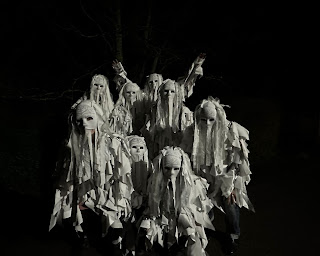If I asked you to name a New Town you might say Welyn Garden City, Milton Keynes or here in Sussex we've got Crawley. Some have fared better than others and many will roll their eyes if you mention Crawley...it would be a lie to pretend it's a pretty place. Its 1950s architecture looks shabby and dated, the town is quite is run down with the rows of vape, nail and tattoo retail outlets and there's poverty. What you don't necessarily appreciate though is that it's got some good facilities, it's very multi cultural [best samosas I've ever had and that's compared to ones I've eaten in Bradford and Leeds] and everyone I met that day was, without exception, really friendly. I hope that the following photos show a more positive side to what can be found if you drill down a bit to find out more.
There have been people living in this area since Mesolithic times and the museum has a very fine collection of flints and bronze age tools to prove it. As only I would my original motivation for travelling over was to see the Bronze Age sword discovered by drainage workers in 1952 in a stream. It was undamaged and all the signs point to it being deliberately put in the water as an offering to the Gods. I love this sculpture called 'Golden Tree' by Joss Smith as it does a lot of the heavy lifting when it comes to explaining some of the history of the town.
.jpg)
The sandstone bottom represents the Jurassic limestone from when the area was all covered in forest, the granite anvil is the ironworking which was a major industry here, the now verdigris axehead started out a gold colour hence the piece's name and the two crows reference the original Saxon name of Crow Lea. This meant the place of crows and is where the name of Crawley is derived from. It sits in the High Street along with some of the lovely older buildings and an imaginative range of modern street furniture. The first editor of Punch, Mark Lemon, used to hold meetings in the white house and other famous names you might recognise from here include Gareth Southgate, Robert Smith [The Cure's frontman] and Romesh Ranganathan.
.jpg)
.jpg)
.jpg)
.jpg)
.jpg)
.jpg)
.jpg)
Whilst there many not be many public works of art in the centre of the town, what they do have are rather eyecatching. These two images are of the Glacial Boulders by Jane Fordham and David Parfitt. The colourful stone sits at the centre with the 9 smaller ones surrounding it. The patterns on them are based on a series of signatures the artists collected from some of the locals!
.jpg)
.jpg)
Slap bang in the middle of town sit both the RC church and the parish one. For those with an interest in graves Lord Alfred Douglas is buried along with his mother in the Catholic cemetery. The name might not ring a bell until I tell you that most people knew him as Bosie and he was famous or perhaps infamous depending upon how you look at it as being Oscar Wilde's lover. I did take the obligatory photo for my records, but would rather share with you the stunning windows from St John's. Looking them up now I find that they are by Burne-Jones and am not surprised that I fell in love with them. His work is fabulous. Beneath each angel were the panel of words which I thought rather moving.
.jpg)
.jpg)
.jpg)
.jpg)
After my bimble around the museum [as that was what I was supposedly there for!] I decided to reacquaint myself with the Victorian bandstand which sits in the middle of the main shopping area of Queen's Square...except it wasn't there. I know it's been a fair few years since I last visited, but I was a tad confused. Am pleased to say though that in the intervening period a piece of land bought in 1921 in memory of the lives lost in the Great War has now been transformed into a well thought out Memorial garden and public green space. The bandstand has undergone an impressive refurb and has been in its new home since 2018. The backstory to this is quite interesting because this is not its first move. When it was first made in 1891 it was to be found at Gatwick. Back then Gatwick was not an airport, but a major racecourse and sufficiently important to have held the Grand National [sorry not a fan] on three occasions during WWII when Liverpool was the target of German bombers and deemed too unsafe. The Crawley Development Corporation bought it in 1948.
.jpg)
Indeed this is not the only item which has transferred from its home in Queen Square. To be honest I don't remember this mosaic, but it was made in the 1950s by Len Baker who worked for Carter Tiles. It was inspired by Lewis Carroll. After it was removed it disappeared until someone put up a photo of it lurking in a pile of rubbish unloved in one of the country parks. The adverse publicity led to a change of heart and I am glad to say that it too was restored and is now back on display for all to enjoy!
So in amongst some of the negative reviews this "New Town" receives there are most definitely some good things to see and celebrate🎈🎈
Arilx

.jpg)
.jpg)
.jpg)
.jpg)
.jpg)
.jpg)
.jpg)
.jpg)
.jpg)
.jpg)
.jpg)
.jpg)
.jpg)
.jpg)
.jpg)
.jpg)
.jpg)
.jpg)
.jpg)
.jpg)
.jpg)
.jpg)
.jpg)
.jpg)
.jpg)
.jpg)

.jpg)
.jpg)
.jpg)
.jpg)
.jpg)
.jpg)
.jpg)
.jpg)
.jpg)
.jpg)



